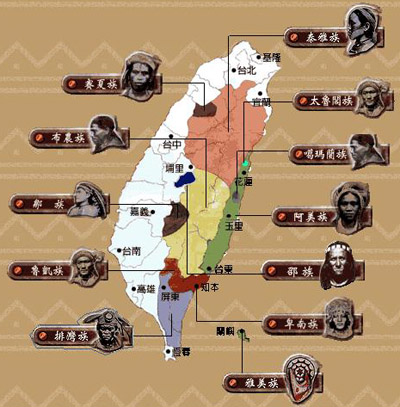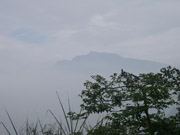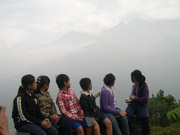The 12 Taiwanese Aborginal Tribes and Statistics: (West to East and North to South)

No. |
Tribe |
Population |
Percentage |
Rank |
1 |
Atayal |
75,633 |
18.3% |
3 |
2 |
Saisiyat |
5,240 |
1.27% |
9 |
3 |
Thou |
572 |
0.15% |
12 |
4 |
Tsou |
6,149 |
1.49% |
8 |
5 |
Bunun |
45,831 |
11.12% |
4 |
6 |
Rukai Tribe |
10,496 |
2.54% |
6 |
7 |
Paiwan Tribe |
77,934 |
18.91% |
2 |
8 |
Truku |
20,721 |
5.02% |
5 |
9 |
Ami |
156,855 |
38.1% |
1 |
10 |
Kumalan |
911 |
0.22% |
11 |
11 |
Puyuma |
9,156 |
2.22% |
7 |
12 |
Yami |
2,712 |
0.66% |
10 |
Total |
12 Tribes |
412,210 |
100% |
|
Data Source:According to December 2005 statistics from the Council of Indigenous Peoples, Executive Yuan

Paiwan Tribe is generally classified into Ravar and Butsul, and the latter is further separated into North, South and East Paiwan Tribes.The North Paiwan Tribe originated from Padain and Paiwan Houses, which sit opposite one another on both sides of upstream Ailiao South River, and although the Houses from Padain are unclear, but the Paiwan Tribes Houses were Tjespaiwan of Ravar while the other, is this House.During the Japanese Occupation period, the Upper Paiwan Houses were called Ravar while the Lower Paiwan Houses were called Butsul.This village is located on the left shore of upstream Ailiao South River on the East face of Tjuliljing Mt. at about 900m above sea level.It is close to North Dawu Mt. and the mountain can be seen by looking eastward from anywhere in the village.The village is also approximately 40km from Pingtung City.
This community is formed by Lower Paiwan Houses and Tjaljavakung.The former is known as Paiwan Village while the later is now called Majia Township Kunshan Lane.Lower Paiwan Village had a population of 1604 people in 1931 during the Japanese Occupation period, which formed the biggest community of Butsul and second-biggest in the whole Paiwan Tribe.The biggest community of Paiwan Tribe should have been Kulou Village of Laiyi Township.
Researched and recorded by:Hsiao-ning, Hsiao-rong, Hsiao-rou

Top |
